Report: Business Environment Analysis and Organizational Functions
VerifiedAdded on 2021/02/22
|14
|3872
|47
Report
AI Summary
This report offers a comprehensive analysis of the business environment, encompassing various organizational functions, including the public, private, and voluntary sectors. It delves into the interrelations between different organizational departments like marketing, finance, and research and development, highlighting their impact on business operations. The report also explores the positive and negative impacts of the macro environment, utilizing PESTLE analysis to examine political, economic, social, technological, legal, and environmental factors affecting businesses. Furthermore, it includes a detailed internal and external analysis of Sainsbury, employing SWOT analysis to evaluate its strengths, weaknesses, opportunities, and threats. The study concludes by examining the interrelation of strengths and weaknesses with external macro factors, providing a holistic view of the business landscape.

Business and the Business
Environment
Environment
Paraphrase This Document
Need a fresh take? Get an instant paraphrase of this document with our AI Paraphraser
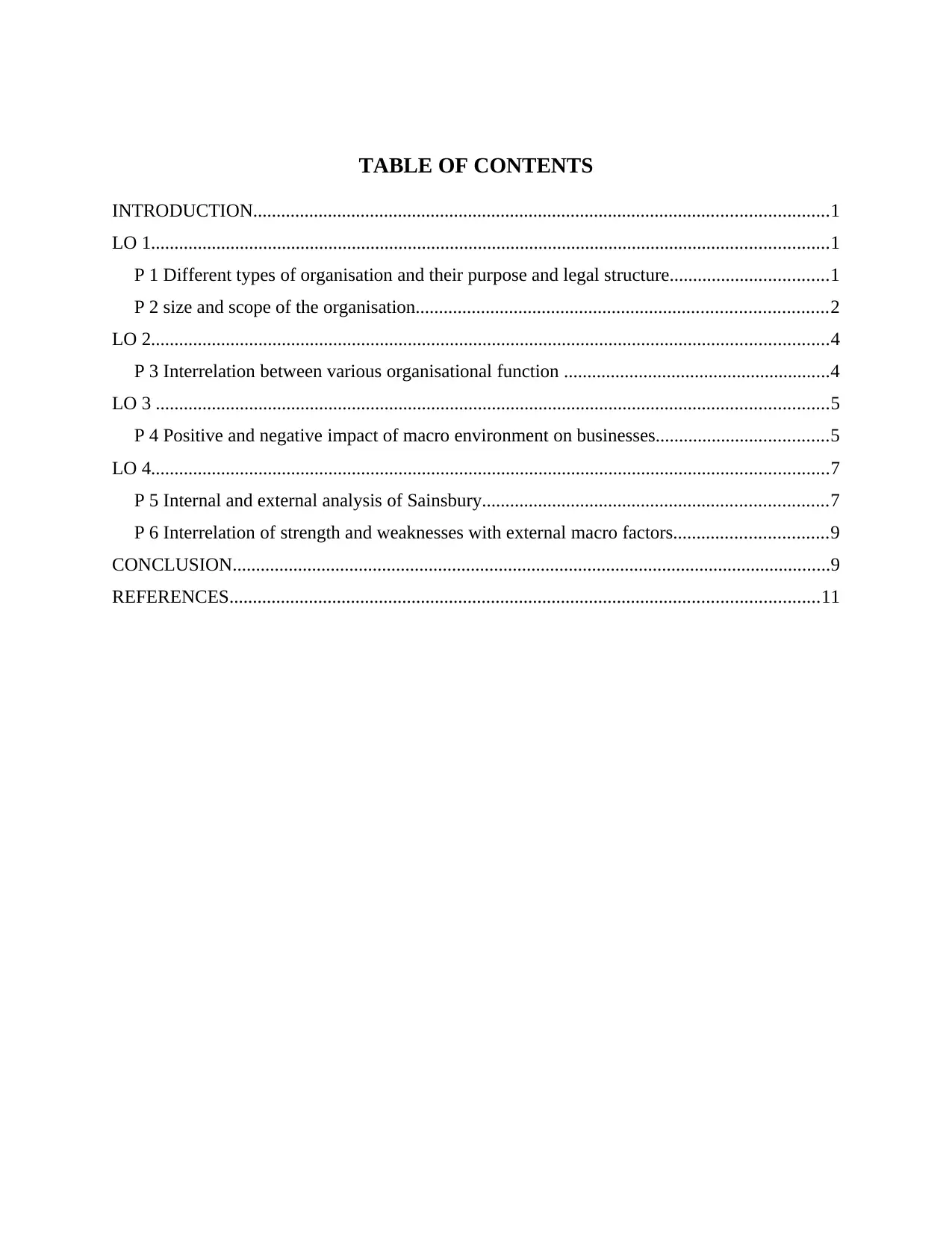
TABLE OF CONTENTS
INTRODUCTION...........................................................................................................................1
LO 1.................................................................................................................................................1
P 1 Different types of organisation and their purpose and legal structure..................................1
P 2 size and scope of the organisation........................................................................................2
LO 2.................................................................................................................................................4
P 3 Interrelation between various organisational function .........................................................4
LO 3 ................................................................................................................................................5
P 4 Positive and negative impact of macro environment on businesses.....................................5
LO 4.................................................................................................................................................7
P 5 Internal and external analysis of Sainsbury..........................................................................7
P 6 Interrelation of strength and weaknesses with external macro factors.................................9
CONCLUSION................................................................................................................................9
REFERENCES..............................................................................................................................11
INTRODUCTION...........................................................................................................................1
LO 1.................................................................................................................................................1
P 1 Different types of organisation and their purpose and legal structure..................................1
P 2 size and scope of the organisation........................................................................................2
LO 2.................................................................................................................................................4
P 3 Interrelation between various organisational function .........................................................4
LO 3 ................................................................................................................................................5
P 4 Positive and negative impact of macro environment on businesses.....................................5
LO 4.................................................................................................................................................7
P 5 Internal and external analysis of Sainsbury..........................................................................7
P 6 Interrelation of strength and weaknesses with external macro factors.................................9
CONCLUSION................................................................................................................................9
REFERENCES..............................................................................................................................11
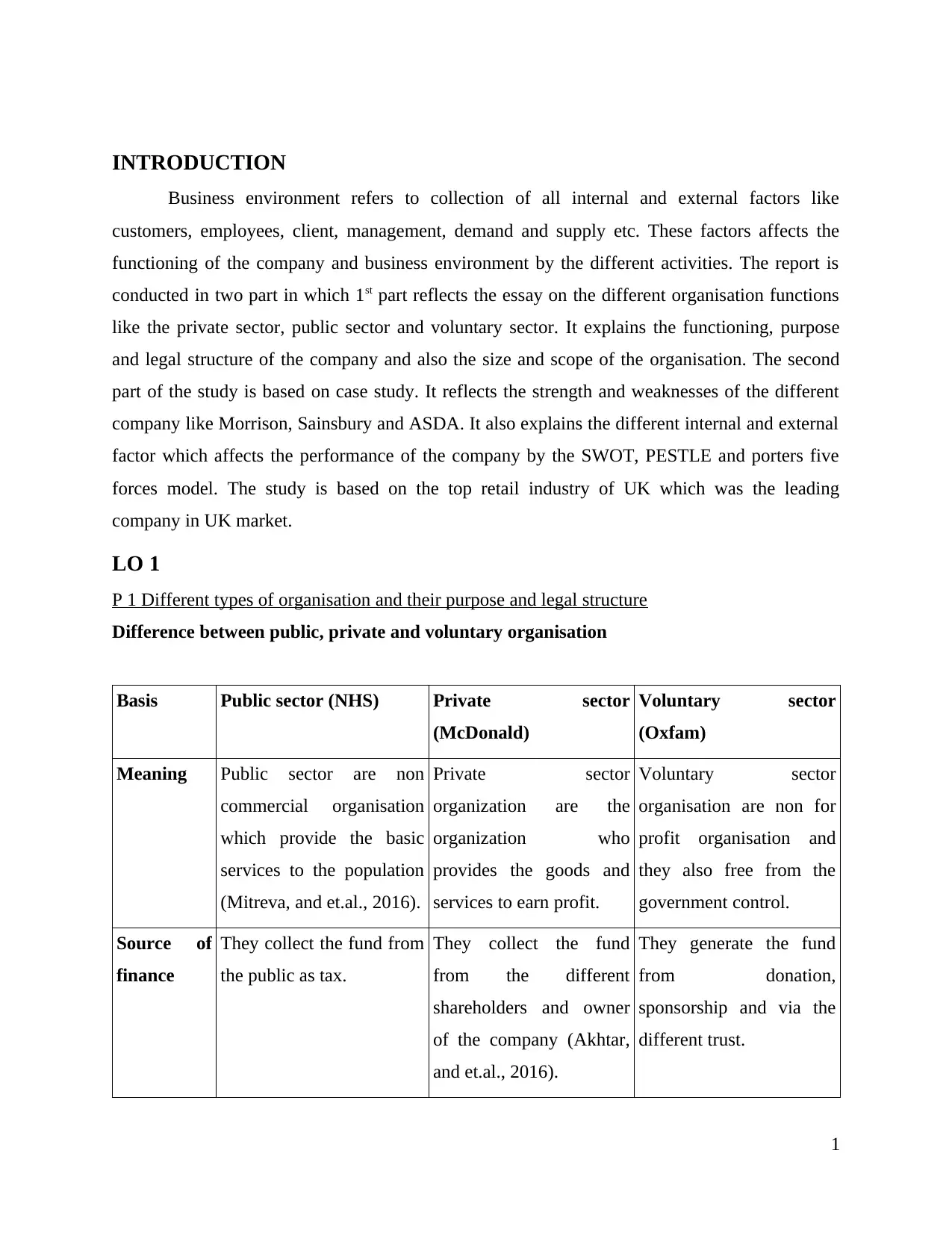
INTRODUCTION
Business environment refers to collection of all internal and external factors like
customers, employees, client, management, demand and supply etc. These factors affects the
functioning of the company and business environment by the different activities. The report is
conducted in two part in which 1st part reflects the essay on the different organisation functions
like the private sector, public sector and voluntary sector. It explains the functioning, purpose
and legal structure of the company and also the size and scope of the organisation. The second
part of the study is based on case study. It reflects the strength and weaknesses of the different
company like Morrison, Sainsbury and ASDA. It also explains the different internal and external
factor which affects the performance of the company by the SWOT, PESTLE and porters five
forces model. The study is based on the top retail industry of UK which was the leading
company in UK market.
LO 1
P 1 Different types of organisation and their purpose and legal structure
Difference between public, private and voluntary organisation
Basis Public sector (NHS) Private sector
(McDonald)
Voluntary sector
(Oxfam)
Meaning Public sector are non
commercial organisation
which provide the basic
services to the population
(Mitreva, and et.al., 2016).
Private sector
organization are the
organization who
provides the goods and
services to earn profit.
Voluntary sector
organisation are non for
profit organisation and
they also free from the
government control.
Source of
finance
They collect the fund from
the public as tax.
They collect the fund
from the different
shareholders and owner
of the company (Akhtar,
and et.al., 2016).
They generate the fund
from donation,
sponsorship and via the
different trust.
1
Business environment refers to collection of all internal and external factors like
customers, employees, client, management, demand and supply etc. These factors affects the
functioning of the company and business environment by the different activities. The report is
conducted in two part in which 1st part reflects the essay on the different organisation functions
like the private sector, public sector and voluntary sector. It explains the functioning, purpose
and legal structure of the company and also the size and scope of the organisation. The second
part of the study is based on case study. It reflects the strength and weaknesses of the different
company like Morrison, Sainsbury and ASDA. It also explains the different internal and external
factor which affects the performance of the company by the SWOT, PESTLE and porters five
forces model. The study is based on the top retail industry of UK which was the leading
company in UK market.
LO 1
P 1 Different types of organisation and their purpose and legal structure
Difference between public, private and voluntary organisation
Basis Public sector (NHS) Private sector
(McDonald)
Voluntary sector
(Oxfam)
Meaning Public sector are non
commercial organisation
which provide the basic
services to the population
(Mitreva, and et.al., 2016).
Private sector
organization are the
organization who
provides the goods and
services to earn profit.
Voluntary sector
organisation are non for
profit organisation and
they also free from the
government control.
Source of
finance
They collect the fund from
the public as tax.
They collect the fund
from the different
shareholders and owner
of the company (Akhtar,
and et.al., 2016).
They generate the fund
from donation,
sponsorship and via the
different trust.
1
⊘ This is a preview!⊘
Do you want full access?
Subscribe today to unlock all pages.

Trusted by 1+ million students worldwide
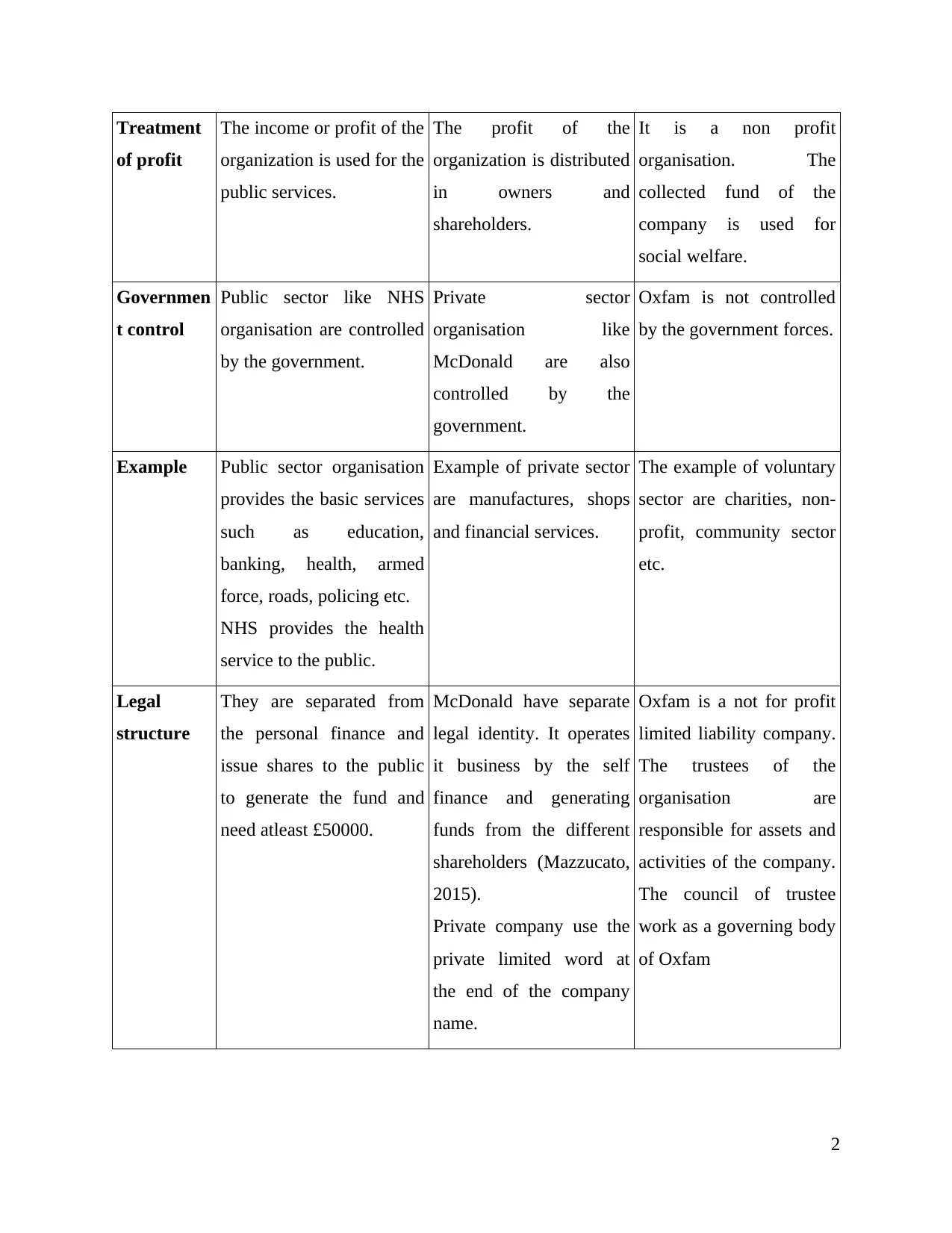
Treatment
of profit
The income or profit of the
organization is used for the
public services.
The profit of the
organization is distributed
in owners and
shareholders.
It is a non profit
organisation. The
collected fund of the
company is used for
social welfare.
Governmen
t control
Public sector like NHS
organisation are controlled
by the government.
Private sector
organisation like
McDonald are also
controlled by the
government.
Oxfam is not controlled
by the government forces.
Example Public sector organisation
provides the basic services
such as education,
banking, health, armed
force, roads, policing etc.
NHS provides the health
service to the public.
Example of private sector
are manufactures, shops
and financial services.
The example of voluntary
sector are charities, non-
profit, community sector
etc.
Legal
structure
They are separated from
the personal finance and
issue shares to the public
to generate the fund and
need atleast £50000.
McDonald have separate
legal identity. It operates
it business by the self
finance and generating
funds from the different
shareholders (Mazzucato,
2015).
Private company use the
private limited word at
the end of the company
name.
Oxfam is a not for profit
limited liability company.
The trustees of the
organisation are
responsible for assets and
activities of the company.
The council of trustee
work as a governing body
of Oxfam
2
of profit
The income or profit of the
organization is used for the
public services.
The profit of the
organization is distributed
in owners and
shareholders.
It is a non profit
organisation. The
collected fund of the
company is used for
social welfare.
Governmen
t control
Public sector like NHS
organisation are controlled
by the government.
Private sector
organisation like
McDonald are also
controlled by the
government.
Oxfam is not controlled
by the government forces.
Example Public sector organisation
provides the basic services
such as education,
banking, health, armed
force, roads, policing etc.
NHS provides the health
service to the public.
Example of private sector
are manufactures, shops
and financial services.
The example of voluntary
sector are charities, non-
profit, community sector
etc.
Legal
structure
They are separated from
the personal finance and
issue shares to the public
to generate the fund and
need atleast £50000.
McDonald have separate
legal identity. It operates
it business by the self
finance and generating
funds from the different
shareholders (Mazzucato,
2015).
Private company use the
private limited word at
the end of the company
name.
Oxfam is a not for profit
limited liability company.
The trustees of the
organisation are
responsible for assets and
activities of the company.
The council of trustee
work as a governing body
of Oxfam
2
Paraphrase This Document
Need a fresh take? Get an instant paraphrase of this document with our AI Paraphraser
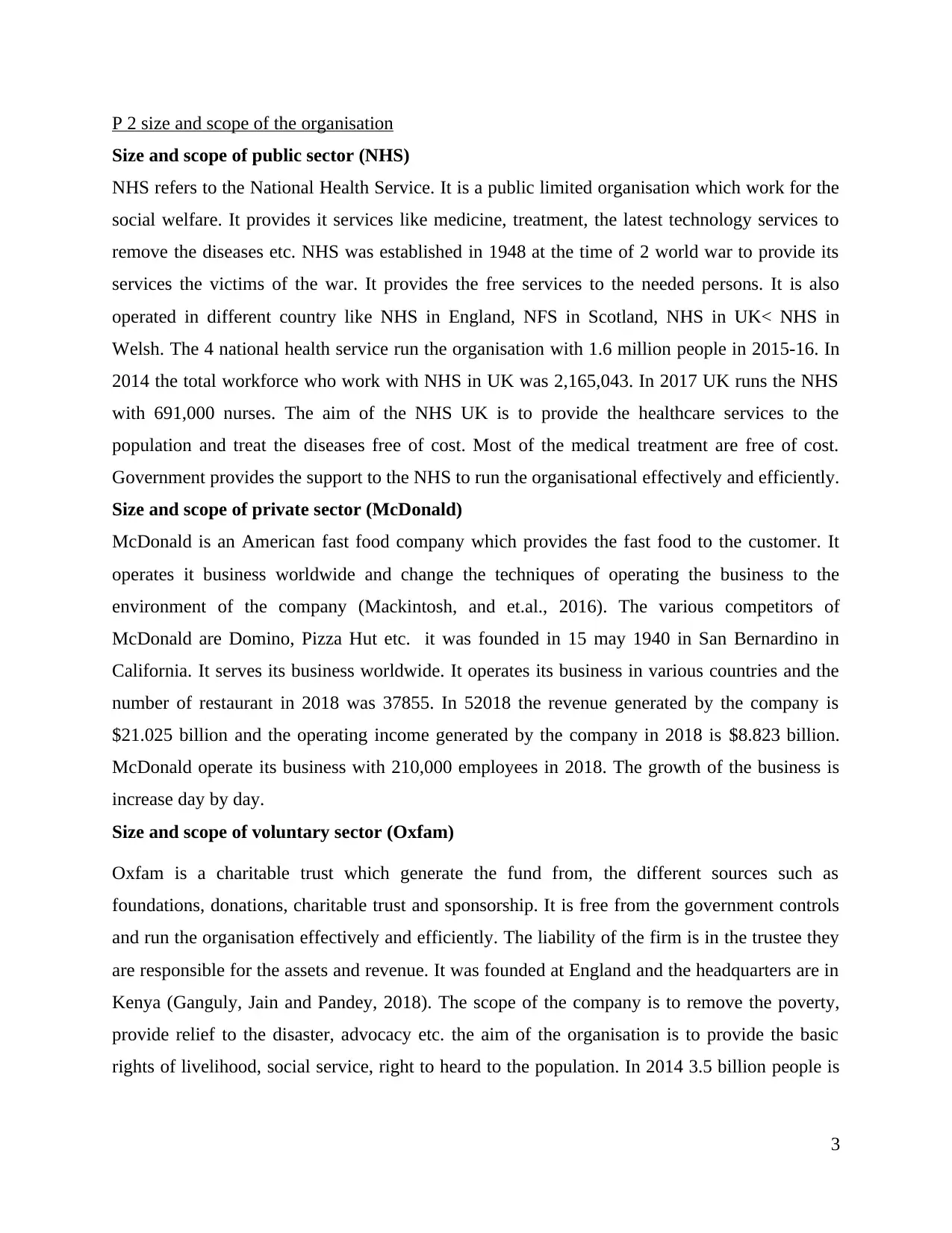
P 2 size and scope of the organisation
Size and scope of public sector (NHS)
NHS refers to the National Health Service. It is a public limited organisation which work for the
social welfare. It provides it services like medicine, treatment, the latest technology services to
remove the diseases etc. NHS was established in 1948 at the time of 2 world war to provide its
services the victims of the war. It provides the free services to the needed persons. It is also
operated in different country like NHS in England, NFS in Scotland, NHS in UK< NHS in
Welsh. The 4 national health service run the organisation with 1.6 million people in 2015-16. In
2014 the total workforce who work with NHS in UK was 2,165,043. In 2017 UK runs the NHS
with 691,000 nurses. The aim of the NHS UK is to provide the healthcare services to the
population and treat the diseases free of cost. Most of the medical treatment are free of cost.
Government provides the support to the NHS to run the organisational effectively and efficiently.
Size and scope of private sector (McDonald)
McDonald is an American fast food company which provides the fast food to the customer. It
operates it business worldwide and change the techniques of operating the business to the
environment of the company (Mackintosh, and et.al., 2016). The various competitors of
McDonald are Domino, Pizza Hut etc. it was founded in 15 may 1940 in San Bernardino in
California. It serves its business worldwide. It operates its business in various countries and the
number of restaurant in 2018 was 37855. In 52018 the revenue generated by the company is
$21.025 billion and the operating income generated by the company in 2018 is $8.823 billion.
McDonald operate its business with 210,000 employees in 2018. The growth of the business is
increase day by day.
Size and scope of voluntary sector (Oxfam)
Oxfam is a charitable trust which generate the fund from, the different sources such as
foundations, donations, charitable trust and sponsorship. It is free from the government controls
and run the organisation effectively and efficiently. The liability of the firm is in the trustee they
are responsible for the assets and revenue. It was founded at England and the headquarters are in
Kenya (Ganguly, Jain and Pandey, 2018). The scope of the company is to remove the poverty,
provide relief to the disaster, advocacy etc. the aim of the organisation is to provide the basic
rights of livelihood, social service, right to heard to the population. In 2014 3.5 billion people is
3
Size and scope of public sector (NHS)
NHS refers to the National Health Service. It is a public limited organisation which work for the
social welfare. It provides it services like medicine, treatment, the latest technology services to
remove the diseases etc. NHS was established in 1948 at the time of 2 world war to provide its
services the victims of the war. It provides the free services to the needed persons. It is also
operated in different country like NHS in England, NFS in Scotland, NHS in UK< NHS in
Welsh. The 4 national health service run the organisation with 1.6 million people in 2015-16. In
2014 the total workforce who work with NHS in UK was 2,165,043. In 2017 UK runs the NHS
with 691,000 nurses. The aim of the NHS UK is to provide the healthcare services to the
population and treat the diseases free of cost. Most of the medical treatment are free of cost.
Government provides the support to the NHS to run the organisational effectively and efficiently.
Size and scope of private sector (McDonald)
McDonald is an American fast food company which provides the fast food to the customer. It
operates it business worldwide and change the techniques of operating the business to the
environment of the company (Mackintosh, and et.al., 2016). The various competitors of
McDonald are Domino, Pizza Hut etc. it was founded in 15 may 1940 in San Bernardino in
California. It serves its business worldwide. It operates its business in various countries and the
number of restaurant in 2018 was 37855. In 52018 the revenue generated by the company is
$21.025 billion and the operating income generated by the company in 2018 is $8.823 billion.
McDonald operate its business with 210,000 employees in 2018. The growth of the business is
increase day by day.
Size and scope of voluntary sector (Oxfam)
Oxfam is a charitable trust which generate the fund from, the different sources such as
foundations, donations, charitable trust and sponsorship. It is free from the government controls
and run the organisation effectively and efficiently. The liability of the firm is in the trustee they
are responsible for the assets and revenue. It was founded at England and the headquarters are in
Kenya (Ganguly, Jain and Pandey, 2018). The scope of the company is to remove the poverty,
provide relief to the disaster, advocacy etc. the aim of the organisation is to provide the basic
rights of livelihood, social service, right to heard to the population. In 2014 3.5 billion people is
3
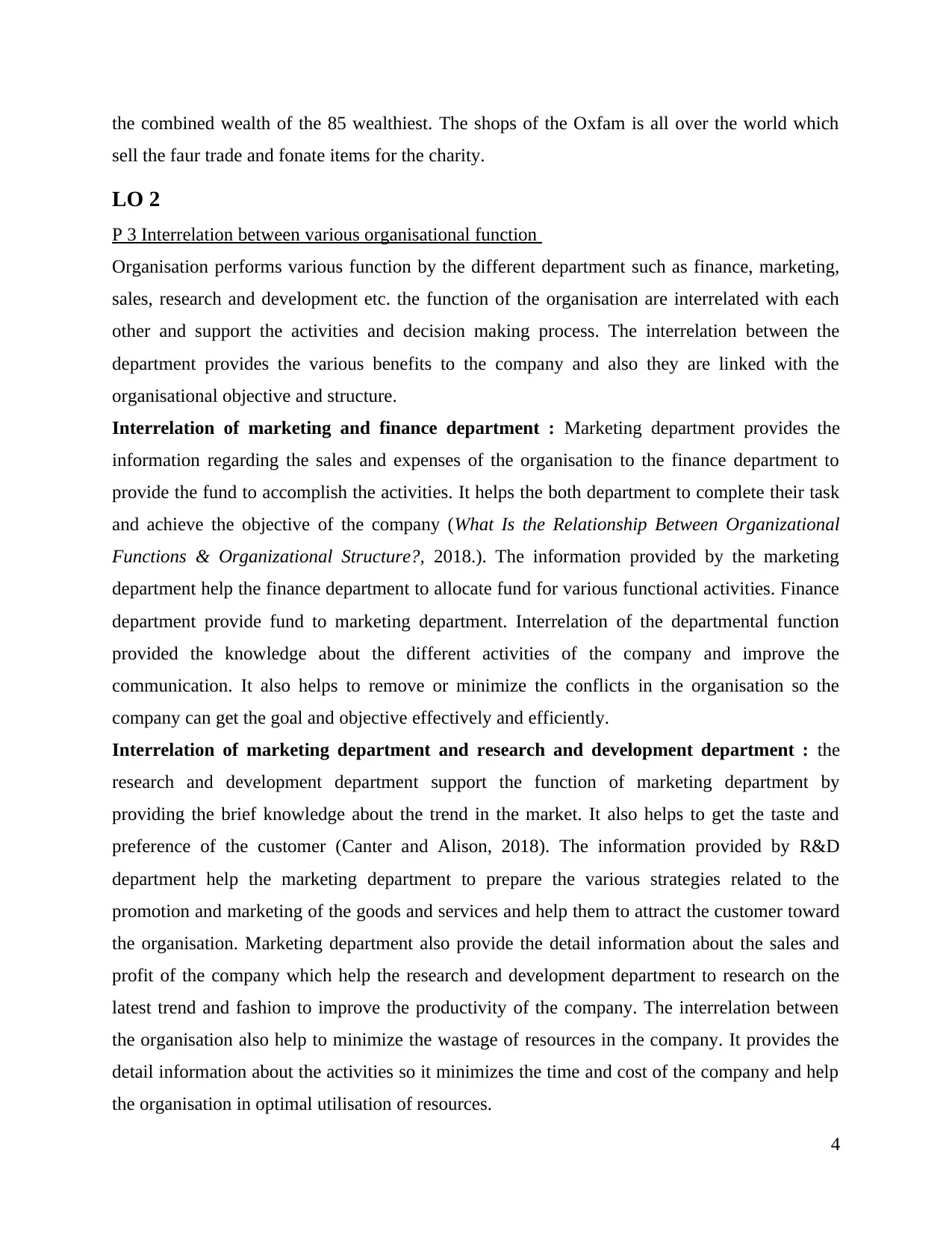
the combined wealth of the 85 wealthiest. The shops of the Oxfam is all over the world which
sell the faur trade and fonate items for the charity.
LO 2
P 3 Interrelation between various organisational function
Organisation performs various function by the different department such as finance, marketing,
sales, research and development etc. the function of the organisation are interrelated with each
other and support the activities and decision making process. The interrelation between the
department provides the various benefits to the company and also they are linked with the
organisational objective and structure.
Interrelation of marketing and finance department : Marketing department provides the
information regarding the sales and expenses of the organisation to the finance department to
provide the fund to accomplish the activities. It helps the both department to complete their task
and achieve the objective of the company (What Is the Relationship Between Organizational
Functions & Organizational Structure?, 2018.). The information provided by the marketing
department help the finance department to allocate fund for various functional activities. Finance
department provide fund to marketing department. Interrelation of the departmental function
provided the knowledge about the different activities of the company and improve the
communication. It also helps to remove or minimize the conflicts in the organisation so the
company can get the goal and objective effectively and efficiently.
Interrelation of marketing department and research and development department : the
research and development department support the function of marketing department by
providing the brief knowledge about the trend in the market. It also helps to get the taste and
preference of the customer (Canter and Alison, 2018). The information provided by R&D
department help the marketing department to prepare the various strategies related to the
promotion and marketing of the goods and services and help them to attract the customer toward
the organisation. Marketing department also provide the detail information about the sales and
profit of the company which help the research and development department to research on the
latest trend and fashion to improve the productivity of the company. The interrelation between
the organisation also help to minimize the wastage of resources in the company. It provides the
detail information about the activities so it minimizes the time and cost of the company and help
the organisation in optimal utilisation of resources.
4
sell the faur trade and fonate items for the charity.
LO 2
P 3 Interrelation between various organisational function
Organisation performs various function by the different department such as finance, marketing,
sales, research and development etc. the function of the organisation are interrelated with each
other and support the activities and decision making process. The interrelation between the
department provides the various benefits to the company and also they are linked with the
organisational objective and structure.
Interrelation of marketing and finance department : Marketing department provides the
information regarding the sales and expenses of the organisation to the finance department to
provide the fund to accomplish the activities. It helps the both department to complete their task
and achieve the objective of the company (What Is the Relationship Between Organizational
Functions & Organizational Structure?, 2018.). The information provided by the marketing
department help the finance department to allocate fund for various functional activities. Finance
department provide fund to marketing department. Interrelation of the departmental function
provided the knowledge about the different activities of the company and improve the
communication. It also helps to remove or minimize the conflicts in the organisation so the
company can get the goal and objective effectively and efficiently.
Interrelation of marketing department and research and development department : the
research and development department support the function of marketing department by
providing the brief knowledge about the trend in the market. It also helps to get the taste and
preference of the customer (Canter and Alison, 2018). The information provided by R&D
department help the marketing department to prepare the various strategies related to the
promotion and marketing of the goods and services and help them to attract the customer toward
the organisation. Marketing department also provide the detail information about the sales and
profit of the company which help the research and development department to research on the
latest trend and fashion to improve the productivity of the company. The interrelation between
the organisation also help to minimize the wastage of resources in the company. It provides the
detail information about the activities so it minimizes the time and cost of the company and help
the organisation in optimal utilisation of resources.
4
⊘ This is a preview!⊘
Do you want full access?
Subscribe today to unlock all pages.

Trusted by 1+ million students worldwide
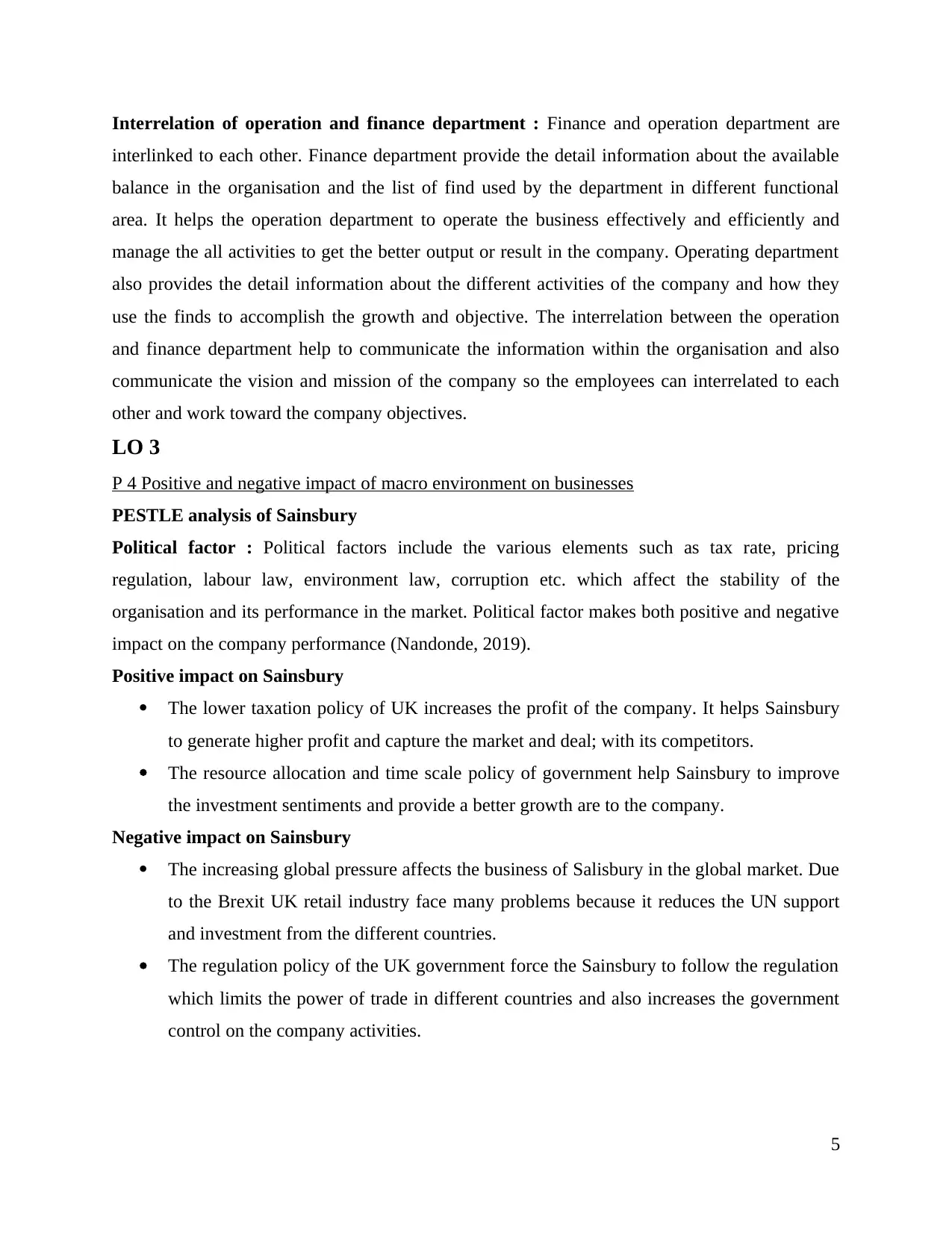
Interrelation of operation and finance department : Finance and operation department are
interlinked to each other. Finance department provide the detail information about the available
balance in the organisation and the list of find used by the department in different functional
area. It helps the operation department to operate the business effectively and efficiently and
manage the all activities to get the better output or result in the company. Operating department
also provides the detail information about the different activities of the company and how they
use the finds to accomplish the growth and objective. The interrelation between the operation
and finance department help to communicate the information within the organisation and also
communicate the vision and mission of the company so the employees can interrelated to each
other and work toward the company objectives.
LO 3
P 4 Positive and negative impact of macro environment on businesses
PESTLE analysis of Sainsbury
Political factor : Political factors include the various elements such as tax rate, pricing
regulation, labour law, environment law, corruption etc. which affect the stability of the
organisation and its performance in the market. Political factor makes both positive and negative
impact on the company performance (Nandonde, 2019).
Positive impact on Sainsbury
The lower taxation policy of UK increases the profit of the company. It helps Sainsbury
to generate higher profit and capture the market and deal; with its competitors.
The resource allocation and time scale policy of government help Sainsbury to improve
the investment sentiments and provide a better growth are to the company.
Negative impact on Sainsbury
The increasing global pressure affects the business of Salisbury in the global market. Due
to the Brexit UK retail industry face many problems because it reduces the UN support
and investment from the different countries.
The regulation policy of the UK government force the Sainsbury to follow the regulation
which limits the power of trade in different countries and also increases the government
control on the company activities.
5
interlinked to each other. Finance department provide the detail information about the available
balance in the organisation and the list of find used by the department in different functional
area. It helps the operation department to operate the business effectively and efficiently and
manage the all activities to get the better output or result in the company. Operating department
also provides the detail information about the different activities of the company and how they
use the finds to accomplish the growth and objective. The interrelation between the operation
and finance department help to communicate the information within the organisation and also
communicate the vision and mission of the company so the employees can interrelated to each
other and work toward the company objectives.
LO 3
P 4 Positive and negative impact of macro environment on businesses
PESTLE analysis of Sainsbury
Political factor : Political factors include the various elements such as tax rate, pricing
regulation, labour law, environment law, corruption etc. which affect the stability of the
organisation and its performance in the market. Political factor makes both positive and negative
impact on the company performance (Nandonde, 2019).
Positive impact on Sainsbury
The lower taxation policy of UK increases the profit of the company. It helps Sainsbury
to generate higher profit and capture the market and deal; with its competitors.
The resource allocation and time scale policy of government help Sainsbury to improve
the investment sentiments and provide a better growth are to the company.
Negative impact on Sainsbury
The increasing global pressure affects the business of Salisbury in the global market. Due
to the Brexit UK retail industry face many problems because it reduces the UN support
and investment from the different countries.
The regulation policy of the UK government force the Sainsbury to follow the regulation
which limits the power of trade in different countries and also increases the government
control on the company activities.
5
Paraphrase This Document
Need a fresh take? Get an instant paraphrase of this document with our AI Paraphraser
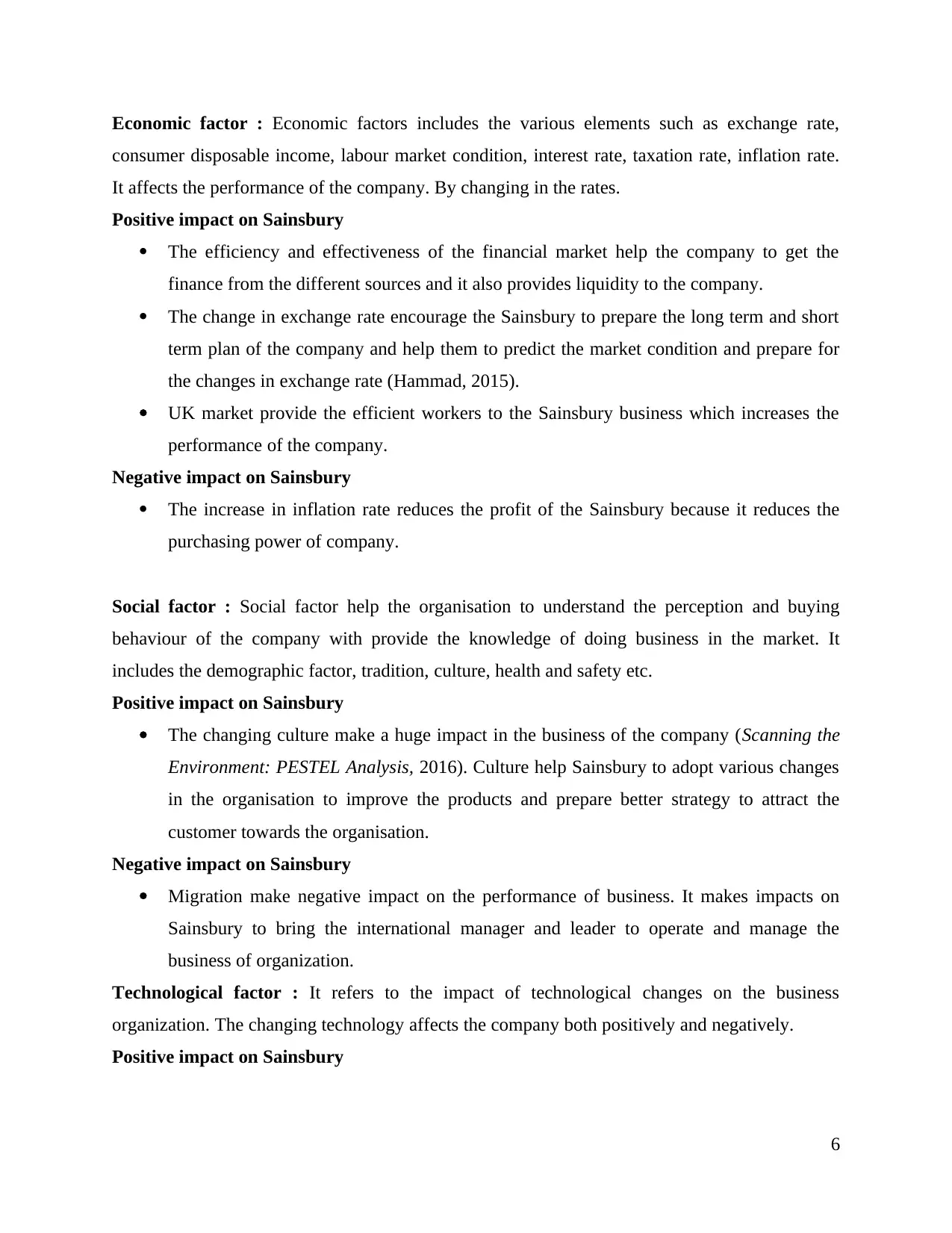
Economic factor : Economic factors includes the various elements such as exchange rate,
consumer disposable income, labour market condition, interest rate, taxation rate, inflation rate.
It affects the performance of the company. By changing in the rates.
Positive impact on Sainsbury
The efficiency and effectiveness of the financial market help the company to get the
finance from the different sources and it also provides liquidity to the company.
The change in exchange rate encourage the Sainsbury to prepare the long term and short
term plan of the company and help them to predict the market condition and prepare for
the changes in exchange rate (Hammad, 2015).
UK market provide the efficient workers to the Sainsbury business which increases the
performance of the company.
Negative impact on Sainsbury
The increase in inflation rate reduces the profit of the Sainsbury because it reduces the
purchasing power of company.
Social factor : Social factor help the organisation to understand the perception and buying
behaviour of the company with provide the knowledge of doing business in the market. It
includes the demographic factor, tradition, culture, health and safety etc.
Positive impact on Sainsbury
The changing culture make a huge impact in the business of the company (Scanning the
Environment: PESTEL Analysis, 2016). Culture help Sainsbury to adopt various changes
in the organisation to improve the products and prepare better strategy to attract the
customer towards the organisation.
Negative impact on Sainsbury
Migration make negative impact on the performance of business. It makes impacts on
Sainsbury to bring the international manager and leader to operate and manage the
business of organization.
Technological factor : It refers to the impact of technological changes on the business
organization. The changing technology affects the company both positively and negatively.
Positive impact on Sainsbury
6
consumer disposable income, labour market condition, interest rate, taxation rate, inflation rate.
It affects the performance of the company. By changing in the rates.
Positive impact on Sainsbury
The efficiency and effectiveness of the financial market help the company to get the
finance from the different sources and it also provides liquidity to the company.
The change in exchange rate encourage the Sainsbury to prepare the long term and short
term plan of the company and help them to predict the market condition and prepare for
the changes in exchange rate (Hammad, 2015).
UK market provide the efficient workers to the Sainsbury business which increases the
performance of the company.
Negative impact on Sainsbury
The increase in inflation rate reduces the profit of the Sainsbury because it reduces the
purchasing power of company.
Social factor : Social factor help the organisation to understand the perception and buying
behaviour of the company with provide the knowledge of doing business in the market. It
includes the demographic factor, tradition, culture, health and safety etc.
Positive impact on Sainsbury
The changing culture make a huge impact in the business of the company (Scanning the
Environment: PESTEL Analysis, 2016). Culture help Sainsbury to adopt various changes
in the organisation to improve the products and prepare better strategy to attract the
customer towards the organisation.
Negative impact on Sainsbury
Migration make negative impact on the performance of business. It makes impacts on
Sainsbury to bring the international manager and leader to operate and manage the
business of organization.
Technological factor : It refers to the impact of technological changes on the business
organization. The changing technology affects the company both positively and negatively.
Positive impact on Sainsbury
6

It helps to improve the efficiency and productivity of the company. Technology helps
Sainsbury to improve the delivery service and provide various channels to promote the
business in other country.
The innovation of technology improve the supply chain and help the Sainsbury to provide
the goods and services worldwide by the online and offline way.
Negative impact on Sainsbury
The disruption in technology affect the whole process of supply chain and also affect the
productivity of the company.
Legal factor : Legal factors play and important role in the organisation performance. It includes
the various law and regulation such as intellectual property right, employment law, safety and
security law etc.
Positive impact on Sainsbury
The different regulation enforce by government help Sainsbury to provide the better
services to the employees and customer which improves the performance of the
company.
The intellectual property rights protect the business of the company from its competitors
Negative impact on Sainsbury
The business law and other legal law bind the business of Sainsbury and limits the power
of doing business in other country.
Environment factor : It forces the company to limits the carbon footprints, climate change etc.
it helps the company to attract the customer and investor towards the company.
Positive impact on Sainsbury
Renewable technology help Sainsbury to settle down its waste and help them to protect
the environment from the hazardous materials.
Negative impact on Sainsbury
The scrutiny by the environment on regular basis affect the Sainsbury. It increases t he
operating cost which directly make an impact on profitability of the company.
LO 4
P 5 Internal and external analysis of Sainsbury
SWOT analysis of Sainsbury
Strength Weaknesses
7
Sainsbury to improve the delivery service and provide various channels to promote the
business in other country.
The innovation of technology improve the supply chain and help the Sainsbury to provide
the goods and services worldwide by the online and offline way.
Negative impact on Sainsbury
The disruption in technology affect the whole process of supply chain and also affect the
productivity of the company.
Legal factor : Legal factors play and important role in the organisation performance. It includes
the various law and regulation such as intellectual property right, employment law, safety and
security law etc.
Positive impact on Sainsbury
The different regulation enforce by government help Sainsbury to provide the better
services to the employees and customer which improves the performance of the
company.
The intellectual property rights protect the business of the company from its competitors
Negative impact on Sainsbury
The business law and other legal law bind the business of Sainsbury and limits the power
of doing business in other country.
Environment factor : It forces the company to limits the carbon footprints, climate change etc.
it helps the company to attract the customer and investor towards the company.
Positive impact on Sainsbury
Renewable technology help Sainsbury to settle down its waste and help them to protect
the environment from the hazardous materials.
Negative impact on Sainsbury
The scrutiny by the environment on regular basis affect the Sainsbury. It increases t he
operating cost which directly make an impact on profitability of the company.
LO 4
P 5 Internal and external analysis of Sainsbury
SWOT analysis of Sainsbury
Strength Weaknesses
7
⊘ This is a preview!⊘
Do you want full access?
Subscribe today to unlock all pages.

Trusted by 1+ million students worldwide
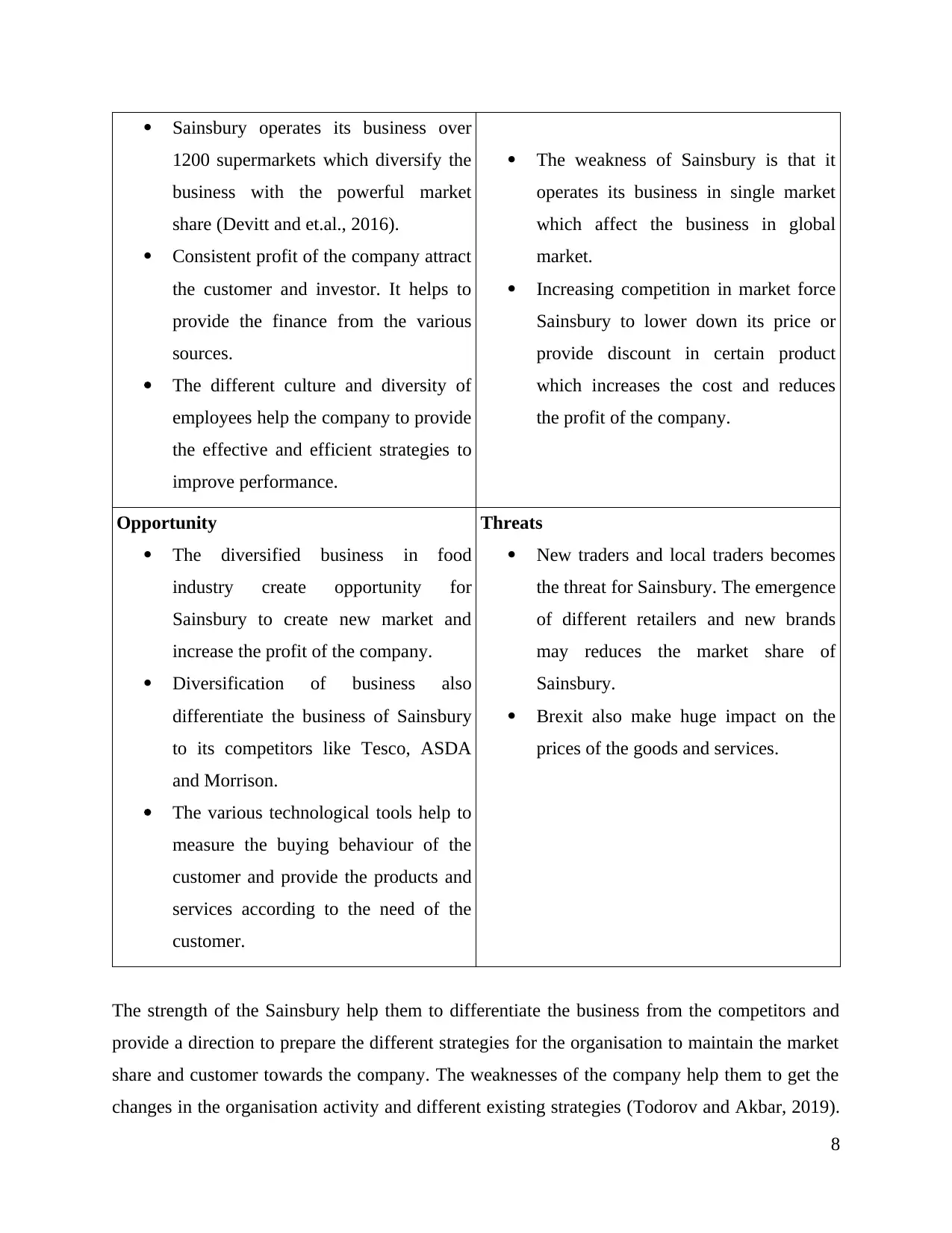
Sainsbury operates its business over
1200 supermarkets which diversify the
business with the powerful market
share (Devitt and et.al., 2016).
Consistent profit of the company attract
the customer and investor. It helps to
provide the finance from the various
sources.
The different culture and diversity of
employees help the company to provide
the effective and efficient strategies to
improve performance.
The weakness of Sainsbury is that it
operates its business in single market
which affect the business in global
market.
Increasing competition in market force
Sainsbury to lower down its price or
provide discount in certain product
which increases the cost and reduces
the profit of the company.
Opportunity
The diversified business in food
industry create opportunity for
Sainsbury to create new market and
increase the profit of the company.
Diversification of business also
differentiate the business of Sainsbury
to its competitors like Tesco, ASDA
and Morrison.
The various technological tools help to
measure the buying behaviour of the
customer and provide the products and
services according to the need of the
customer.
Threats
New traders and local traders becomes
the threat for Sainsbury. The emergence
of different retailers and new brands
may reduces the market share of
Sainsbury.
Brexit also make huge impact on the
prices of the goods and services.
The strength of the Sainsbury help them to differentiate the business from the competitors and
provide a direction to prepare the different strategies for the organisation to maintain the market
share and customer towards the company. The weaknesses of the company help them to get the
changes in the organisation activity and different existing strategies (Todorov and Akbar, 2019).
8
1200 supermarkets which diversify the
business with the powerful market
share (Devitt and et.al., 2016).
Consistent profit of the company attract
the customer and investor. It helps to
provide the finance from the various
sources.
The different culture and diversity of
employees help the company to provide
the effective and efficient strategies to
improve performance.
The weakness of Sainsbury is that it
operates its business in single market
which affect the business in global
market.
Increasing competition in market force
Sainsbury to lower down its price or
provide discount in certain product
which increases the cost and reduces
the profit of the company.
Opportunity
The diversified business in food
industry create opportunity for
Sainsbury to create new market and
increase the profit of the company.
Diversification of business also
differentiate the business of Sainsbury
to its competitors like Tesco, ASDA
and Morrison.
The various technological tools help to
measure the buying behaviour of the
customer and provide the products and
services according to the need of the
customer.
Threats
New traders and local traders becomes
the threat for Sainsbury. The emergence
of different retailers and new brands
may reduces the market share of
Sainsbury.
Brexit also make huge impact on the
prices of the goods and services.
The strength of the Sainsbury help them to differentiate the business from the competitors and
provide a direction to prepare the different strategies for the organisation to maintain the market
share and customer towards the company. The weaknesses of the company help them to get the
changes in the organisation activity and different existing strategies (Todorov and Akbar, 2019).
8
Paraphrase This Document
Need a fresh take? Get an instant paraphrase of this document with our AI Paraphraser
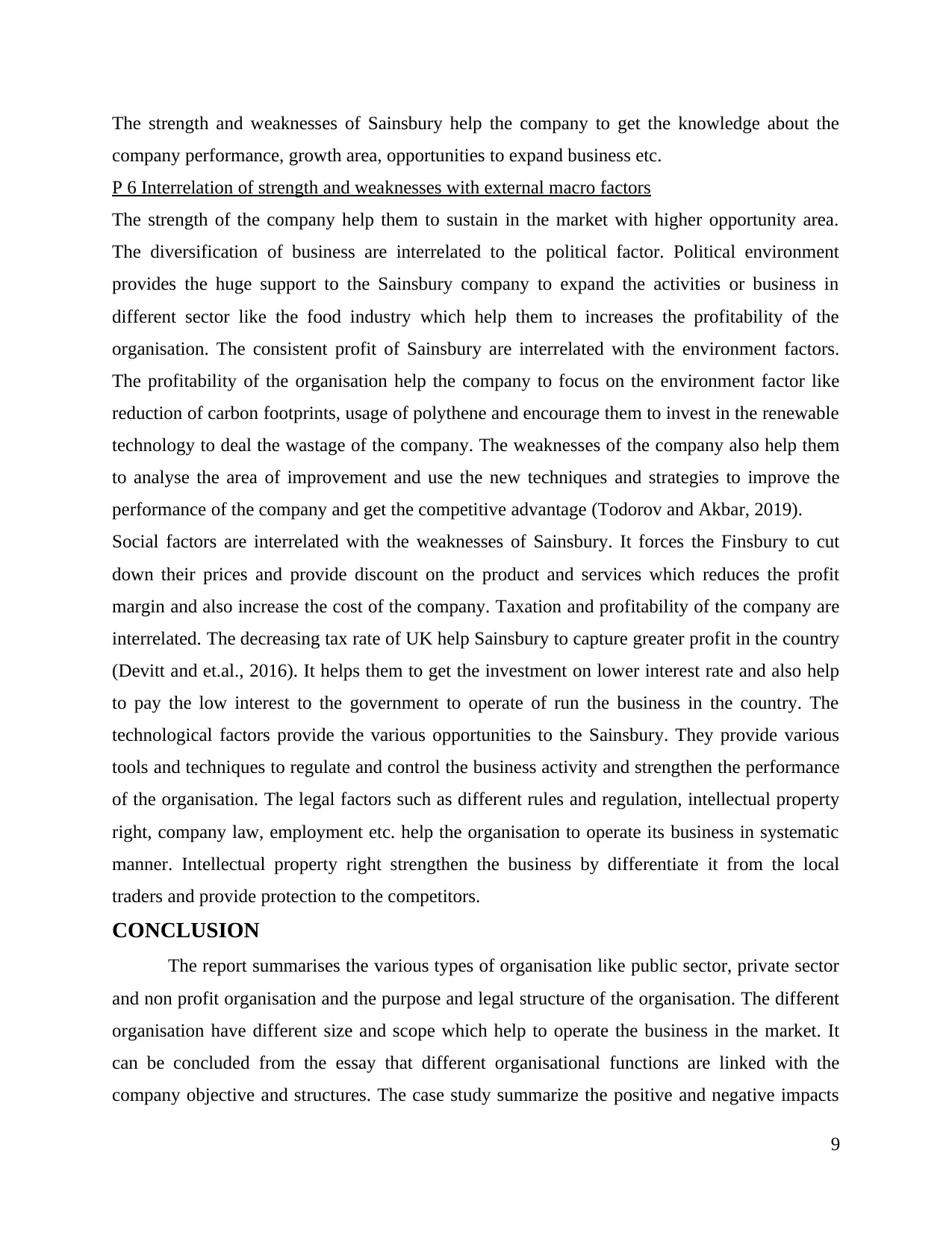
The strength and weaknesses of Sainsbury help the company to get the knowledge about the
company performance, growth area, opportunities to expand business etc.
P 6 Interrelation of strength and weaknesses with external macro factors
The strength of the company help them to sustain in the market with higher opportunity area.
The diversification of business are interrelated to the political factor. Political environment
provides the huge support to the Sainsbury company to expand the activities or business in
different sector like the food industry which help them to increases the profitability of the
organisation. The consistent profit of Sainsbury are interrelated with the environment factors.
The profitability of the organisation help the company to focus on the environment factor like
reduction of carbon footprints, usage of polythene and encourage them to invest in the renewable
technology to deal the wastage of the company. The weaknesses of the company also help them
to analyse the area of improvement and use the new techniques and strategies to improve the
performance of the company and get the competitive advantage (Todorov and Akbar, 2019).
Social factors are interrelated with the weaknesses of Sainsbury. It forces the Finsbury to cut
down their prices and provide discount on the product and services which reduces the profit
margin and also increase the cost of the company. Taxation and profitability of the company are
interrelated. The decreasing tax rate of UK help Sainsbury to capture greater profit in the country
(Devitt and et.al., 2016). It helps them to get the investment on lower interest rate and also help
to pay the low interest to the government to operate of run the business in the country. The
technological factors provide the various opportunities to the Sainsbury. They provide various
tools and techniques to regulate and control the business activity and strengthen the performance
of the organisation. The legal factors such as different rules and regulation, intellectual property
right, company law, employment etc. help the organisation to operate its business in systematic
manner. Intellectual property right strengthen the business by differentiate it from the local
traders and provide protection to the competitors.
CONCLUSION
The report summarises the various types of organisation like public sector, private sector
and non profit organisation and the purpose and legal structure of the organisation. The different
organisation have different size and scope which help to operate the business in the market. It
can be concluded from the essay that different organisational functions are linked with the
company objective and structures. The case study summarize the positive and negative impacts
9
company performance, growth area, opportunities to expand business etc.
P 6 Interrelation of strength and weaknesses with external macro factors
The strength of the company help them to sustain in the market with higher opportunity area.
The diversification of business are interrelated to the political factor. Political environment
provides the huge support to the Sainsbury company to expand the activities or business in
different sector like the food industry which help them to increases the profitability of the
organisation. The consistent profit of Sainsbury are interrelated with the environment factors.
The profitability of the organisation help the company to focus on the environment factor like
reduction of carbon footprints, usage of polythene and encourage them to invest in the renewable
technology to deal the wastage of the company. The weaknesses of the company also help them
to analyse the area of improvement and use the new techniques and strategies to improve the
performance of the company and get the competitive advantage (Todorov and Akbar, 2019).
Social factors are interrelated with the weaknesses of Sainsbury. It forces the Finsbury to cut
down their prices and provide discount on the product and services which reduces the profit
margin and also increase the cost of the company. Taxation and profitability of the company are
interrelated. The decreasing tax rate of UK help Sainsbury to capture greater profit in the country
(Devitt and et.al., 2016). It helps them to get the investment on lower interest rate and also help
to pay the low interest to the government to operate of run the business in the country. The
technological factors provide the various opportunities to the Sainsbury. They provide various
tools and techniques to regulate and control the business activity and strengthen the performance
of the organisation. The legal factors such as different rules and regulation, intellectual property
right, company law, employment etc. help the organisation to operate its business in systematic
manner. Intellectual property right strengthen the business by differentiate it from the local
traders and provide protection to the competitors.
CONCLUSION
The report summarises the various types of organisation like public sector, private sector
and non profit organisation and the purpose and legal structure of the organisation. The different
organisation have different size and scope which help to operate the business in the market. It
can be concluded from the essay that different organisational functions are linked with the
company objective and structures. The case study summarize the positive and negative impacts
9

of macro environment on the business operation that political factor strengthen the performance
of the organisation. The reduction in tax rate improves the profit of the company and help them
to earn more money in the market. It can be concluded from the case study that the different
strategies apply by the supermarket make and huge impact on their performance. It also explains
the interrelation of strength and weakness of the company to the external macro factors.
10
of the organisation. The reduction in tax rate improves the profit of the company and help them
to earn more money in the market. It can be concluded from the case study that the different
strategies apply by the supermarket make and huge impact on their performance. It also explains
the interrelation of strength and weakness of the company to the external macro factors.
10
⊘ This is a preview!⊘
Do you want full access?
Subscribe today to unlock all pages.

Trusted by 1+ million students worldwide
1 out of 14
Related Documents
Your All-in-One AI-Powered Toolkit for Academic Success.
+13062052269
info@desklib.com
Available 24*7 on WhatsApp / Email
![[object Object]](/_next/static/media/star-bottom.7253800d.svg)
Unlock your academic potential
Copyright © 2020–2025 A2Z Services. All Rights Reserved. Developed and managed by ZUCOL.





